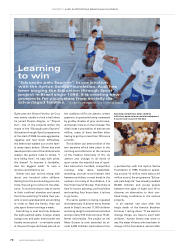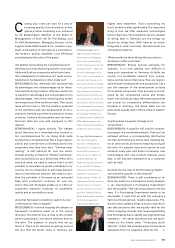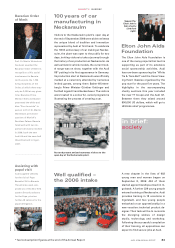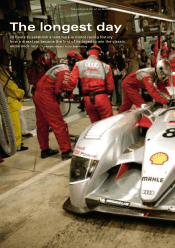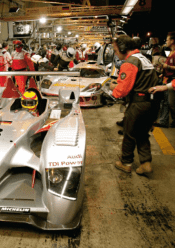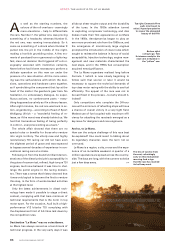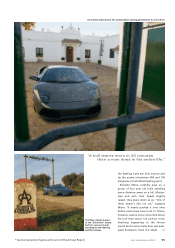Audi 2006 Annual Report Download - page 88
Download and view the complete annual report
Please find page 88 of the 2006 Audi annual report below. You can navigate through the pages in the report by either clicking on the pages listed below, or by using the keyword search tool below to find specific information within the annual report.
all about sheer engine output and the durability
of the tyres. In the 1930s attention turned
to exploiting compressor technology, and disc
brakes made their first appearance at Le Mans
in the 1950s. Aerodynamics began to play an
ever more prominent role from the 1960s on, and
the emergence of monstrously large engines
prompted the introduction of clever rules which
sought to redress the balance in favour of social
acceptability. Injection technology, engine man-
agement and new materials characterised the
next steps, and in the 1990s fuel consumption
acquired new significance.
The Le Mans organisers realised long before
Formula 1 (which is now slowly beginning to
follow suit) that sooner or later it would be
necessary to square the technical demands of
top-class motor racing with the ability to use fuel
efficiently. The appeal of the race was not to
be sacrificed in the process – but why should it,
indeed?
Only competitors who complete the 24-hour
race with a minimum of refuelling stops will have
a chance of overall victory in a very tight field.
Modest use of fuel coupled with maximum effi-
ciency for attacking the racetrack emerged as a
key issue for designers and race engineers.
And so, to Le Mans.
How can the unique challenge of this race best
be explained? One could resort to talking about
its legendary character, were the term not so
over-used.
Le Mans is a region, a city, a race and the expe-
rience of an incredible weekend. A quarter of a
million spectators are spread across the country-
side. The days are long, with the summer solstice
just a few days away. >>
The kiss of sunrise from
the east, refreshingly
early on this midsummer
morning. And a sign
that the race has reached
its half-way mark.
Top right: Emanuele Pirro
pulls into the pit to
refuel. A good perspective
to savour the elongated
beauty of the R10.
Bottom right:
raring to go. Tom
Kristensen ready for his
next stint in Number 7,
the “yellow” one.
SPORT: THE AUDI R10 TDI AT LE MANS
86 AUDI 2006 ANNUAL REPORT
As well as the starting numbers, the
colours of the roll-over bars – seemingly
mere elevations – help to differentiate
the cars. Number 7, the yellow one, was proving
something of a headache, whereas Number 8,
the red one, was running immaculately. So it
came as something of a shock when Number 8
pulled into the pit in the middle of the night,
making a horrible grumbling noise. A few mo-
ments of paralysed horror gave way to a lightning-
fast, clear-cut decision that triggered off a chor-
eography executed with instinctive certainty.
Never before had it been necessary to perform a
delicate operation on this new car under the
pressure of a race situation. All the more amaz-
ing was the self-evidence with which the deci-
sions, operations and hardware came together,
as if symbolising the component that lay at the
heart of the matter: the gearbox’s gear train. No
hesitation, no unnecessary dialogue, no super-
fluous actions, no cumbersome parts – every-
thing happened as calmly as if in a theory lesson.
After eight minutes, the red one was back in ac-
tion, engendering – according to Head of Sport
Wolfgang Ullrich – a “wonderful feeling of re-
lease, as if the worst was already behind us. We
had that tremendous feeling of being perfectly
in control – everyone working as a team.”
The whole affair showed that there are no
special rules or benefits for those who venture
into virgin territory. The utterly new and highly
revolutionary TDI racing car did not have even
the slightest period of grace and was expected
to bypass several decades of experience in con-
ventional racing cars at a stroke.
Following on from the brand’s brilliant demon-
strations of the diesel principle’s acceptability in
the guise of economical, refined, high-torque TDI
engines, Audi now believed it was time to chal-
lenge the petrol engine in the racing domain,
too. There was a sense that history decreed that
it was only logical to become the first to venture
this step, in the form of works-backed activities
at the highest level.
Only the latest achievements in diesel tech-
nology have made it possible to stage a direct
contest, complying with that bare minimum of
technical requirements that is the norm in top
motor sport. For the occasion, Audi built a high-
performance V12 biturbo TDI complying with
the displacement limit of 5.5 litres laid down by
the competition rules.
Destination “Le Mans” was no coincidence.
Le Mans has always served as a benchmark of
technical progress. In the very early days it was


